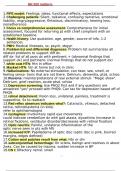NR 509 midterm
1.FIFE model: Feelings, ideas, functional effects, expectations
2.Challenging patients: Silent, talkative, confusing narrative, emotional
liability, angry/aggressive, flirtatious, discriminatory, hearing loss,
nonadherence
3.Focus vs comprehensive assessment: Comprehensive for initial
assessment, focused for returning pt with chief compliant with an
established baseline.
4.Health history: Use quotation, age, gender, source of info, 1-2
sentences
5.PMH: Medical illnesses, sx, psych, obgyn
6.Problem list and differential diagnoses: Problem list summarizes all
related problems to support diff dx.
diff dx- list of all poss dx with pertinent + (abnormal findings that
support dx) and pertinent- (normal findings that do not support dx)
7.white coat HTN: Htn in office
8.Masked HTN: htn at home but not in clinic
9.Hallucinations: No external stimulation, can hear, see, smell, or
feeling sensa- tions that are not there. Delirium, dementia, ptsd, schizo
10.Illusions: misinterpretations of real external stimuli. "Magic show".
Delirium, grief reaction, acute ptsd, schizo
11.Depression screening: Use PHQ2 first and if any questions are
answered "yes" proceed with PHQ9. Can tax for depression based off of
PHQ9.
12.retinal detachment: Vision loss, unilateral, painless, treatment is
supportive. Sx to reattach
13.Red reflex absences indicates what?: Cataracts, vitreous, detached
retina, retinoblastoma (in kids).
refer to ophthalmologist
14.nystagmus: Involuntary rapid eye movements
could indicate cerebellum dz with gait ataxia, dysarthria (increase in
retinal fixation), vestibular disorder(decreases with retinal fixation)
15.Optic neuritis: Painful, unilateral inflammation of the
optic nerve seen in pts with MS
16.increased ICP: Papilledema of optic disc (optic disc is pink, blurred
margins, edges defined)
17.Cotton wool patches result from what: Htn or dm
18.subconjunctival hemorrhage: On sclera, benign and resolves in about
2wks. Can be caused by trauma, sudden increase in BP
19.CN I: Olfactory nerve: smell
1/
8




